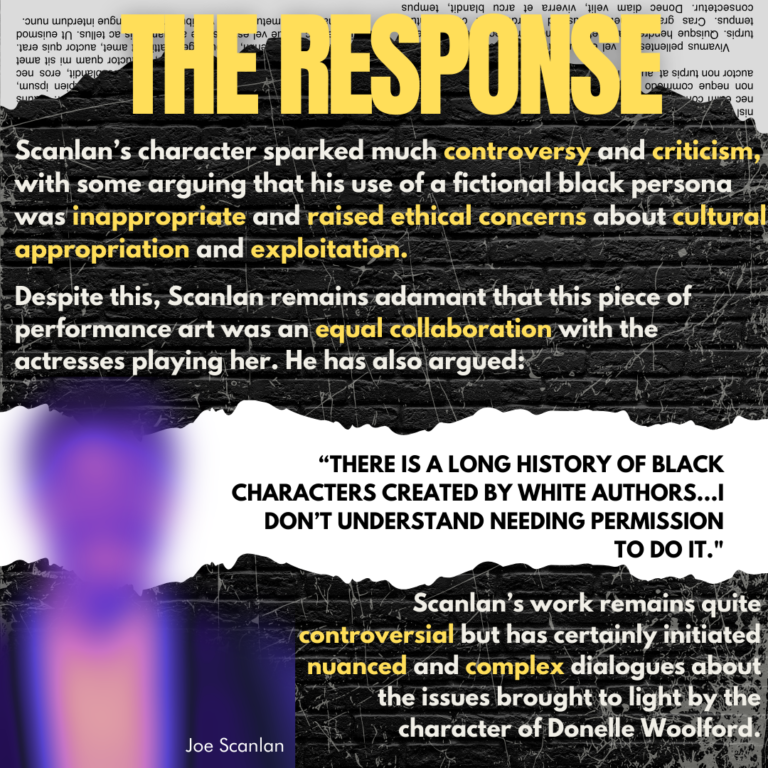The story of White is inspired by the true story that took place in the Whitney Museum of American Art in New York City.
More resources here:
Education Guide: Read the full story in the education guide found here.
The Trouble with Donelle Woolford by Jennifer Krasinski and Lauren O’Neill-Butler – The DIS Blog
Art and race at the Whitney: Rethinking the Donelle Woolford debate
BY CAROLINA A. MIRANDACOLUMNIST Los Angeles Times – JUNE 17, 2014 5 AM PTRacially Themed Work Stirs Conflict at Whitney Biennial by Felicia R. Lee
New York Times – May 16, 2014- OPINION: Racism and the Barbican’s ‘Exhibit B’ by T. O. Molefe New York Times – Oct. 27, 2014






Guest Essay: HWITE
by Kenya (Robinson). LLC

I love my Afro. It is a sable cloud, a medieval halo that reminds me of my mother and sharpens our resemblance. Hair picked to achieve maximum radius, the soft crinkle recalls a black and white photograph that is among my most prized possessions. Two figures predominate – my mother, be-’froed and bespeckled, holding a notepad, upon which, the other person, appears to be signing an autograph. I’d never thought much about the other figure or the circumstances around the image until I recognized the geometric print of the signer’s dress, late 1960s sock-it-to-me style. This gridded pattern has been oft repeated on Black History Month calendars, google image searches, and appropriately reverential artistic renderings of a particular presidential candidate from 1972.
“I am black and I am a woman so I’ve got two strikes against me right away”, a significant refrain of my particular embodiment. I am an avatar of ethnicity. Assigned the task of culture-making, without recompense, no less apparent than when the Afro is in full effect. I cannot count the number of occasions where a phenotypical member of the HWITE tribe has insisted that their well-intentioned compliment of my cocoa coiffure must involve the touching of my person. Or, more accurately, plunging their well-meaning-not-racist-digits into my aforementioned medieval halo.
This is a global phenomenon. Shanghai to Seattle. And even that one time in business class – I’ve had to remind the HWITES of their early childhood home training, “keep your hands to yourself” or “use your words”. Etcetera. If we are to consider a shared American history as an established rubric, it’s no wonder that HWITE folks, and, HWITE men in particular, believe that Black women’s bodies are best considered under their guidance (surveillance?). Or, as outlined by the play WHITE by James Ijames, most suitable as an archetype for professional currency. ‘Shake that money maker’, and other such time-honored maxims. The Kardashians, along with a host of older-others, have made their fortunes upon Black femme embodiment. Only to discard the husks, once the value has been severely extracted. Universal uterine interdimensional portals. Sex as production, non-consensual, and complicated. Mama’s baby, papa’s maybe an entry on the plantation ledger, Jefferson style. Or, lot number so-and-so, on the auction block.
I’ve known a Gus, or twenty, in my time. Joes in different areas codes, of Ivy League extraction with a penchant for minstrelsy, presented as a thinly veiled thought experiment. Gus or Joe or Dave or some other moniker swimming in the same talent pool of future executioner, ahem, executive. Waterlogged. Shirley sells seashells at the seashore all while claiming that “other kinds of people can steer the ship of state besides white men”. Irrespective of these Other Kinds of People, we seem committed to the Captain. Conditioned to give credit undeserved. At least a little bit. “Why would you want someone else to take credit for your work?” Vanessa asks. Credit, from the Latin creditum is defined as “a loan, thing entrusted to another,” and the neuter past participle of credere – “to trust, entrust, believe”. And here lies the fulcrum of WHITE’s machinations. Of the balkanization of Balkonaé. The guile of Gus. The truth of Tanner and the juxtaposition of Jane. Trust and belief are tenuously connected, especially when taking credit for another’s work is the prima materia. I just wished I could’ve warned VanKneesia.

